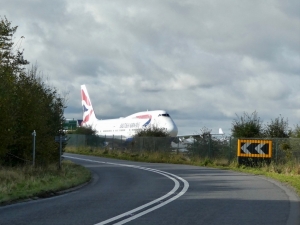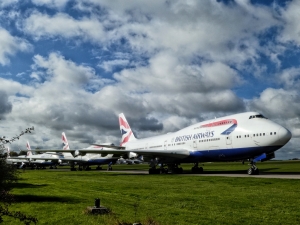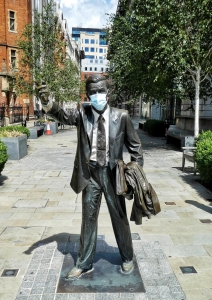END OF THE ROAD FOR THE QUEEN OF THE SKIES

On the 8th of October, the last two 747 400s in the BA fleet departed for the scrap yard. The intention was to keep the 747s flying for a few more years but Covid put an end to that. It’s ironic that the last few jumbos to leave Heathrow were parked opposite a Covid testing centre! Cotswold Airport (formerly RAF Kemble) has a dozen BA 747s on the ground. They include G-CIVB, one the last to leave Heathrow. At the time of writing, she still had her engines. The airfield is well worth a visit. For details go to www.cotswoldairport.com.The airfield is also home to ASI International a leader in aircraft disassembly, with 100,000 sq. ft. of climate-controlled component/engine storage.
Fleet

BOAC operated its first 747 London to New York service on 14th April 1971 and in July 1989 the first British Airways 747-400 flew. At its peak, the airline had a fleet of 57 747-400s. Alex Cruz, the (now former!) CEO commented “This is not how we wanted or expected to have to say goodbye to our incredible fleet of 747 aircraft. It is a heart-breaking decision to have to make. So many people, including many thousands of our colleagues past and present, have spent countless hours on and with these wonderful planes – they have been at the centre of so many memories, including my very first long-haul flight”.
Seats
My seats of choice were 62A or 62K upstairs and 2A in the posh seats at the front. If my memory is correct, in 1988 I flew on a BA747-200 to Islamabad from Heathrow via Manchester. The upper deck on this aircraft had economy seating and can best be described as cosy!
Not quite the end…
The 747-800s will be around for some time with 47 passenger and 106 freighter variants delivered. Two will be configured as Air Force One Presidential aircraft. Lufthansa is the largest operator of the passenger variant with 19 in the fleet. Many more 747 cargo aircraft will continue to serve the global marketplace. It is estimated that there are nearly 300 of these aircraft in service with a potential future lifespan of 20 years.
HELLO TESTING?
“Test & test again

To many observers, it seems apparent that quarantine in the UK isn’t working — for those who comply, it can be overly restrictive, while others simply ignore it. But with infection numbers once again rising across the globe, the government remains firmly on the side of quarantine, pointing to the fact that testing isn’t infallible, and could give, according to our Prime Minister, “a false sense of security”. False negative results are a valid concern. These can happen when the virus is incubating and contagious but not detectable. Then there’s the risk of inconclusive, misappropriated or vastly delayed results — the latter currently seen at test centres nationwide.
But with airport testing in place at destinations across Europe and beyond, and the likes of Italy offering rapid antigen tests that produce results within 30 minutes, it seems clear that the UK lags well behind a test-and-trace approach to travel”. National Geographic, 25 September. www.nationalgeographic.co.uk
LA LA LAND?
Has the UK Government responded? Sort of – by postponing any decisions until November!
The really bad news is that a taskforce has been mooted, to be led by the Transport Secretary Grant Shapps and Health Secretary Matt Hancock. The latter appears to have the sincerity of a quiz show host, over promising and under delivering. They will review:
- How a testing regime for international arrivals could be implemented, including exactly when passengers would be tested
- How to raise consumer confidence to support the recovery of international travel
- What “innovating testing models and other non-testing means” could boost travel

ABTA, The UK Travel Trade Body has noted: “Without tailored support, including further grants to aid recovery, travel agents in particular face a very difficult few months ahead. These businesses, the vast majority of whom are SMEs, and which includes high-street businesses that are an integral part of communities across the UK, have had no revenue for nearly a year. The Job Support Scheme, which requires people to pay a minimum of 55% of salaries, does not go far enough for these businesses to avoid difficult decisions to let go of valued of staff members.
It is vital that the Global Travel Taskforce launched this month to consider a testing regime, and other measures to support the recovery of the travel industry, acts decisively and urgently to help increase consumer confidence and get the industry moving again. www.abta.com
Keep all your fingers crossed!
MANAGING REALITY
Whilst British Cabinet Ministers delay, IATA faces up to the reality of managing during a crisis: “We are burning through cash because we cannot cut costs fast enough to make up for the impact of not being able to do business. Borders for the most part remain closed.
We believe that there is a solution. As we have spoken about in these briefings for the past few weeks, we continue to push for systematic testing for COVID-19 prior to departure. We believe that should give governments the confidence to re-open borders. We are advocating for that with governments, the health authorities, WHO and through ICAO.
Airlines did receive $160 billion in support from governments. That was a lifeline. We would have seen many more bankruptcies and job losses without it. Now, most of those programs are ending. So, it is time to ask governments to take extra measures to replace or extend them into the longer term. The potential for failures and job losses in the coming months is enormous.
Today I want to emphasize that this is not just an airline problem. We know that our airport and air navigation service partners are also struggling”. IATA BRIEFING 6th October.
Stuart McAdam
TheMcAdamee ~ Farewell Jumbo, Hello Testing? ~